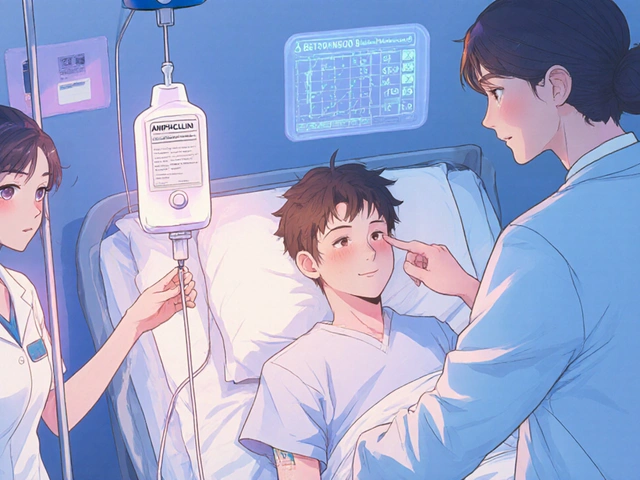
TL;DR
- Minipress is the brand name for prazosin, an alpha‑blocker used mainly for high blood pressure and PTSD‑related nightmares.
- Typical starting dose is 1mg at bedtime; most patients reach 5‑10mg/day, split in 2‑3 doses.
- Watch for first‑dose dizziness, fainting, or a sudden drop in blood pressure.
- Common side effects: headache, fatigue, nasal congestion; serious reactions are rare but include severe low blood pressure.
- Check with your doctor before combining with other antihypertensives, erectile‑dysfunction meds, or grapefruit juice; use a reputable pharmacy for purchase.
What Is Minipress?
Minipress is the trade name for the generic drug prazosin. It belongs to a class called alpha‑adrenergic blockers. These medicines relax the smooth muscle in blood vessels, which lets blood flow more easily and reduces the pressure against the artery walls. While it was first approved in the 1970s for hypertension, doctors have found a second life for it in treating PTSD‑related nightmares and certain urinary‑tract symptoms.
Because it works on the nerves that tighten blood vessels, prazosin is sometimes called a “vasodilator.” The effect starts within 30minutes of the first dose, but full blood‑pressure control usually takes a few weeks of steady dosing.
When and Why Doctors Prescribe Minipress
There are three main reasons a clinician might write a Minipress prescription:
- High blood pressure (essential hypertension). If you’ve tried lifestyle changes or other drug classes without success, prazosin can be added as a second‑line agent.
- Post‑traumatic stress disorder (PTSD) nightmares. Numerous clinical trials (e.g., Raskind etal., 2023) show that low‑dose prazosin cuts the frequency of trauma‑related nightmares by up to 70%.
- Benign prostatic hyperplasia (BPH) symptoms. By relaxing the bladder neck, it can ease urinary urgency and weak stream.
Doctors choose Minipress over other antihypertensives when a patient also has sleep‑disturbing PTSD or when they need a drug that won’t increase heart rate. It’s not a first‑choice for people with severe heart failure because its blood‑pressure‑lowering effect can be too abrupt.
How to Take Minipress: Dosage & Administration
Getting the dose right is the biggest factor in avoiding the “first‑dose effect”-a sudden dip in blood pressure that can make you feel light‑headed or faint. Below is a step‑by‑step guide most clinicians follow.
| Condition | Starting Dose | Typical Target Dose | Maximum Daily Dose |
|---|---|---|---|
| Hypertension | 1mg once daily (often at bedtime) | 5‑10mg divided BID or TID | 20mg |
| PTSD Nightmares | 1mg at bedtime | 2‑3mg at bedtime (may increase to 5mg) | 15mg |
| BPH Symptoms | 1mg daily | 5mg daily | 10mg |
Key points while you start:
- Take the first dose at night to reduce the chance of dizziness during the day.
- Swallow tablets whole with a glass of water; don’t crush them.
- If you miss a dose, take it as soon as you remember-unless it’s almost time for the next dose. In that case, skip the missed one.
- Never double‑up. The drug’s half‑life is about 2‑3hours, but its blood‑pressure effect can linger.
After the first week, schedule a follow‑up with your provider. Blood‑pressure readings should slowly trend down; if they stay high, the doctor may add another antihypertensive.
Common Side Effects and What to Watch For
Most people tolerate Minipress well, especially when the dose is increased gradually. Here’s a quick cheat‑sheet of side effects, ranked by how often they show up.
- Very common (≥10%): Dizziness, headache, fatigue, nasal congestion, palpitations.
- Common (1‑10%): Nausea, dry mouth, mild edema, insomnia, visual disturbances.
- Rare (<1%): Priapism, severe hypotension, heart rhythm changes, liver enzyme elevation.
Red‑flag symptoms that need immediate medical attention include:
- Sudden, severe drop in blood pressure (feeling faint even when seated)
- Chest pain or irregular heartbeat
- Swelling of the face or throat (possible allergic reaction)
- Persistent, worsening headache coupled with vision changes
Most side effects ease within a few days as your body adjusts. If they persist past two weeks, call your clinician.

Interactions, Precautions, and Who Should Avoid Minipress
Because Minipress works on the same receptors that many other drugs target, there are a handful of interactions you should be aware of.
- Other antihypertensives (ACE inhibitors, beta‑blockers, diuretics) can amplify blood‑pressure drops.
- Phosphodiesterase‑5 inhibitors (Viagra, Cialis) may cause unexpected fainting.
- MAO‑inhibitors and certain antidepressants can heighten dizziness.
- Grapefruit juice interferes with the liver enzymes that break down prazosin, potentially raising its level.
Precautions:
- Pregnant or breastfeeding women should only use Minipress if the benefit clearly outweighs risk.
- Elderly patients often need a lower starting dose because they’re more prone to orthostatic hypotension.
- Patients with severe liver disease may need dosage adjustments.
People with a history of “first‑dose effect” or those who already take multiple blood‑pressure meds should discuss a slower titration schedule with their doctor.
Where to Get Minipress Safely
Since Minipress is a prescription drug, you’ll need a doctor’s order before you can fill it. Here’s a quick roadmap to avoid scams and stay compliant:
- Schedule a telehealth or in‑person appointment. Most primary‑care physicians can prescribe it if your blood‑pressure readings or PTSD symptoms meet the criteria.
- Ask for a written or electronic prescription. If you’re using an online pharmacy, the site should require a valid prescription upload.
- Choose a licensed pharmacy. Look for a verification badge (e.g., NABP Verified Internet Pharmacy).
- Check price transparency. Generic prazosin costs about $4‑$10 for a 30‑day supply, while the brand Minipress can be $30‑$50.
- Set up refill reminders. Missing doses can cause blood‑pressure spikes; many pharmacy apps send alerts.
If you’re uninsured, community health clinics often provide low‑cost prescriptions, and some states have patient‑assistance programs for brand‑name drugs.
Mini‑FAQ
- Can I stop Minipress suddenly? No. Stopping abruptly can cause a rebound rise in blood pressure. Taper under doctor supervision.
- Is Minipress safe for people with diabetes? Generally yes, but monitor blood‑pressure more closely because diabetes can affect autonomic regulation.
- Will Minipress affect my sexual performance? Rarely, it can cause priapism (persistent erection). If that happens, seek emergency care.
- How long does it take to see improvement in PTSD nightmares? Many patients notice a reduction within 1‑2weeks, but optimal effect often appears after 4‑6weeks.
- Can I take Minipress with alcohol? Alcohol also lowers blood pressure, so mixing can increase dizziness. Limit intake and discuss with your provider.
Next Steps & Troubleshooting
If you’ve just started Minipress and feel a mild head‑spin when you stand up, try these quick fixes:
- Rise slowly-sit up for a minute before standing.
- Stay hydrated; aim for at least 8 glasses of water daily.
- Split the dose: take half at bedtime, half in the morning.
Should symptoms persist after a week, contact your clinic. They might lower the dose or add a low‑dose thiazide diuretic to smooth out the pressure curve.
For those considering a switch to a generic version, ask your pharmacist whether the brand and generic have the same inactive ingredients; some people react to dyes in the brand tablets.
Finally, keep a simple log: date, dose, blood‑pressure reading, and any side effects. A two‑week pattern gives your doctor the data they need to fine‑tune the regimen.




I’ve been on prazosin for PTSD nightmares for 8 months now. Honestly? Life-changing. I used to wake up screaming 3-4 times a week. Now? Maybe once a month. Started at 1mg, bumped to 3mg after a week. No dizziness because I took it at bedtime like they said. Don’t sleep on this med. It’s not magic, but it’s close. 🙏
I’m a primary care doc, and I’ve prescribed this to 12 veterans over the past year. The PTSD data is solid-better than SSRIs for nightmares, and way fewer sexual side effects. But I always warn patients: the first dose is a gamble. One guy passed out in his bathroom. We now have a protocol: first dose in clinic, 30-min observation. If you’re taking it at home? Have someone else drive you the next day. Safety first.
Ugh. Another pharma shill post. Prazosin? It’s just a blood pressure drug that got lucky because someone noticed veterans stopped having nightmares. The VA pushed it because it’s cheap. Meanwhile, real trauma therapy? Underfunded. Don’t let a pill make you think you’re healed. You’re not. You’re just sedated. And if you’re taking it with alcohol? You’re asking for a hospital trip. #PharmaLies
Ah, the Cartesian duality of pharmacological intervention-where the mind, a mere epiphenomenon of neuronal firing, is coerced into stillness by alpha-adrenergic antagonism. One must ask: is the reduction of nightmares a true healing, or merely the suppression of the soul’s protest against an unhealed world? Prazosin does not resolve trauma-it silences its echo. And in doing so, does it not also silence the very mechanism that compels us toward integration? The body remembers. The mind forgets. But the drug? The drug merely... neutralizes. And is neutrality, in the face of suffering, not a kind of betrayal?
I’m American. I don’t need some foreign drug to fix my brain. We got therapy. We got prayer. We got grit. Prazosin? That’s a socialist fix for weak people. My uncle was in Vietnam-he didn’t take pills. He drank whiskey and shot guns. And he slept fine. Maybe if you just stopped being so soft, you wouldn’t need this crap. 🇺🇸
I read this entire post. It is well-structured. However, I must point out that the table lacks units for the maximum daily dose in the BPH column. It says '10mg'-but is that 10 mg per day? Per dose? Per week? This is dangerously ambiguous. As a medical professional, I find this omission unacceptable. Furthermore, the phrase 'don’t crush them' is grammatically informal and lacks precision. It should read: 'Do not crush the tablets.' This is not pedantry. It is responsibility.
They never tell you the real reason they push prazosin. It’s because the VA is trying to cut costs on EMDR therapy. This drug is a Band-Aid. And guess who’s making money? Pfizer. And the FDA. And the doctors who get kickbacks from pharma reps. You think this is science? It’s a cover-up. They’re drugging veterans so they don’t protest the wars. Wake up. The nightmares aren’t the problem-the system is.
I just started this last week for nightmares after my dad passed. It’s been 4 days and I slept through the night for the first time in 2 years. I cried. Not because I’m sad-because I felt peace. Thank you to whoever wrote this. It’s rare to see a post this clear. I’m gonna tell my therapist about it tomorrow. 💛
This whole thing is overcomplicated. Just take 1mg at night. If you feel dizzy, lie down. If you don’t feel dizzy, you’re fine. Done. Why do people need 10 paragraphs for a pill?
Ah yes, the classic 'start low, go slow' approach-because nothing says 'I care about your safety' like a drug that can knock you out like a sack of potatoes if you're not careful. I've seen patients on this who can't stand up without holding onto furniture. But hey, at least their nightmares are gone, right? 😌 Just don't forget to check your blood pressure before you try to walk to the fridge. And maybe... don't drive. At all. Ever. Until you're sure. You're welcome.